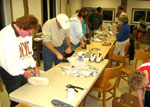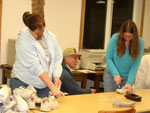Posted on Monday, November 13, 2006
Several times a year the local Kiwanis Club comes to the Nature Center at the Field Station to work! They are good workers. On November 9, nine Kiwanis and two Circle K members spent an evening scrutinizing and bagging 1,180 athletic shoes that had come from the closets of the community. Why would anyone want to "scrutinize" old, worn (sometimes smelly) athletic shoes? Here is why. They can be recycled BUT metal eyelets and decorative emblems must be cut out of the shoes before that can happen. This requires scrutiny, sharp blades and muscle.
Recycling athletic shoes is part of a green movement that is sponsored by Nike, Inc., the company everyone knows. They have, since 1993, supported recycling their (and other manufacturer's) castaways. They responded to these consumer questions: "What's to become of those tired and worn-out old friends? Relegated forever to the back of the closet? Donated to a secondhand store or garage sale? Deposited in the - ugh - landfill?"
In February 2005 the local Kiwanis Club started a project that centered on making a contribution to NikeGO, Nike's program to promote healthier lifestyles for kids through physical activity. The initial local goal was stated in the cliché, "Five thousand in O-Five." The intent was to collect and recycle 5,000 shoes from our area in 2005. This required the placing of 23 shoe collection bins (effectively garbage cans identified for "shoes only") in local schools, churches and community buildings. Westminster College got seven of these for residence halls, gymnasiums and campus center. Labels designated these bins as receptacles for any brand of athletic shoes. A phone number on the label identified who to call when the bin needed to be emptied. When Kiwanis members went regularly to empty bins they discovered what most people already know: PEOPLE DO NOT READ! The bins usually had shoes (including women's stiletto heeled shoes) but often ordinary trash. Sometimes there was only trash!
A place for storing, sorting, scrutinizing, snipping and bagging shoes became a reasonable part of the mission of Westminster's Field Station. That's the reason for the November 9 get together in the Nature Center. Sharp utility knives, snippers and other blades were used to cut out metal. Shoe laces can stay. The shoes, 20 to a bag, are temporarily stored at the Field Station until they can be taken to the Nike Factory Store in the Grove City Outlet Mall. Oh, there are always interesting comments while sorting shoes: "Aren't these cute!" one would exclaim about a tiny pair of shoes scarcely three inches long. "Wow, we must have gotten shoes from a basketball team of giants!" when about five size 17 shoes were found. "Look at these" when bright orange shoes showed up. One shoe had in it a dead mouse and there are always spiders to contend with! There is lots of laughter, trivial chatter and . . . afterwards, something to eat as the evening of work winds down.
Here is what happens next. The athletic shoes are sent by the Nike store to Portland, Oregon where Nike has its manufacturing (and recycling) plant. There the Reuse-A-Shoe program kicks in. Athletic shoes of any brand, and Nike shoes that are returned due to a material or workmanship flaw, are separated into three main materials - upper fabric, midsole foam and outsole rubber - and then ground up. Each of these materials is used in a different way to make sports-related products. There is "Nike Grind Rubber," from outsoles, that becomes baseball and soccer fields, as well as golf products, weight room flooring and running tracks. "Nike Grind Foam," from midsoles, is used in synthetic basketball courts, tennis courts and playground surfacing. And "Nike Grind Upper Fabric," from textile and leather uppers, is used for padding under hardwood basketball floors.
Since the company began the Reuse-A-Shoe program in 1993, Nike has helped donate more than 170 sport surfaces, called NikeGO Places, to communities around the world. The surfaces use Nike Grind material as a component of the total surface composition. Kids win because many of these sports surfaces are donated in communities where they wouldn't otherwise have access to high-performance sports surfaces. It's also a win for the environment, as hundreds of thousands of athletic shoe materials are diverted from landfills. The Reuse-A-Shoe program has expanded around the world, with projects in the U.K., Australia and Japan.
Did the local project in 2005 meet its goal of "5,000 in 05"? Yes . . . and more. The project has continued and, since the 2005 start up, has rescued 8,488 athletic shoes from landfills. By weight, this equals a bit over 3 tons. The evening's effort on the 9th processed nearly 1,200 (850 pounds) of these castaways. Among all of the shoes processed to date, 1,400 were good enough to be reused and were not shipped to Nike. They were washed, sanitized, checked for quality, given new shoestrings if needed . . . and donated to the Salvation Army Thrift store in New Castle for immediate reuse!
Where can old athletic shoes be deposited for recycling? First of all, all brands of athletic shoes are acceptable but make sure they are athletic shoes. Flip-flops, sandals or regular shoes or boots cannot, at this time, be recycled. Check your closets . . . then look around in your church, in one of the district's schools or in public buildings of the borough and townships. You can identify those black, plastic bins by the words, "Reuse-A-Shoe," on the top. Drop shoes in regularly and often! How hard can that be?
Shoe recycling, just a tiny part of living green, is a way of life at the Field Station. Our Nature Center is an 1877 vintage barn that has seen much life and now shines green with efforts of putting the "4 Rs" into practice. Everyone knows the mantra -- Reduce, Reuse, Recycle. What is the 4th R? Respect!
Clarence Harms, Director Field Station

